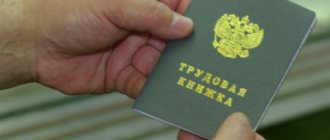Who needs statistics and why?
The task of statistics is to track the process of replenishing budgets at different levels. But it not only records the size of actual tax revenues and their dynamics. The Federal Tax Service receives information about arrears of taxes and budget payments from organizations and the population.
Analysis of debts on taxes and fees allows you to assess the state of affairs in the tax sphere, identify reserves for replenishing the treasury, and organize work with non-payers. The prosecutor's office has the right to bring offenders to administrative or criminal liability.
Statistics allow the state to judge the tax burden of enterprises and, if necessary, regulate it legislatively.
“Manual” for the inspector: we follow the logic of the Federal Tax Service
The Vedomosti publication refers to non-public documents of the Federal Tax Service, which they managed to gain access to. It became known what exactly the service is guided by when selecting candidates for a tax audit.
At the end of 2022, the Federal Tax Service developed criteria and its own regulations for assessing art. 54.1 of the Tax Code, the provisions of which regulate the methods of identifying abuse and tax evasion.
The purpose of the “pre-screening analysis” is to identify companies or individual entrepreneurs that:
✅ evade taxes,
✅ they will actually be able to pay all arrears and fines after inspection or they have property that can be collected.
In fact, no one is interested in fly-by-night and tech companies. The tax authorities are interested in those from whom you can really “fuck”. This non-public system for identifying “tax evaders” makes it possible with a high degree of probability to weed out “technical stuff” from a really working business.
The assessment of a company for the risks of non-payment of taxes is based on data from automated control systems available to the Federal Tax Service.
For example, ASK VAT not only monitors VAT risks, but also looks for options for evasion of other taxes and identifies gaps along the entire chain of company counterparties.
Types and functions of tax statistics
The issue of taxation in Russia is regulated by Tax legislation. Tax revenue statistics indicate compliance with the principles that were formulated by the English economist Adam Smith in the 18th century:
- justice;
- certainty;
- convenience;
- saving.
Tax statistics of the Russian Federation are fully consistent with the experience of countries with a federal structure. It is an economic lever that allows you to influence production in the country. In conditions of underfunding of the state budget, the tax system should first of all stimulate economic development. Functions of tax system statistics:
- Collection of information about the processes occurring in the regional economy.
- Analysis and processing of collected information.
- Identification of patterns in ongoing processes.
- Studying the influence of external factors on the profitability of budgets of all levels.
Russian tax statistics divide taxes into:
- federal;
- regional;
- local.
The essence of taxes is revealed by their functions - fiscal, regulatory and control. The fiscal function allows you to cover the expenditure side of the budget. If there is a preponderance towards the regulatory function, then tax revenue statistics may record a decrease in their collection.
The regulatory function influences the weakening or strengthening of capital growth, the rate of development of production activity, and the increase or decrease in the solvency of the population. Tax reporting statistics note the so-called “lag effect” of the regulatory function. Its essence lies in the indirect impact on ongoing processes and the need for a certain time for their implementation. The control function is responsible for tax collection. Her tasks:
- demand compliance with fiscal discipline;
- determine the procedure for tax audits;
- prevent tax crimes.
To implement the control function, the Prosecutor's Office of the Russian Federation and the Ministry of Internal Affairs are involved.
Statistics of the tax system of the Russian Federation
To fill the budget and resolve national issues, general and special taxes and fees are used. The Federal Tax Service includes the following taxes:
- transport;
- fees for the reproduction of the mineral resource base.
Federal tax statistics distribute the ratio of total taxes as follows:
- Personal income tax – 42%.
- Income tax – 26%.
- Excise taxes – 14%.
- Property fees – 9%.
- Other taxes are 9%.
Tax revenue statistics for 2014–2016 recorded an increase of 26.5%. Transport taxes refer to regional fees. Their size largely depends on the decisions of regional authorities. They are given the right:
- establish regional benefits;
- change the transport tax rate by region, but not more than 10 times (Article 361 of the Tax Code of the Russian Federation);
- determine the timing and procedure for paying transport tax for legal entities.
Rosstat recorded the highest transport tax rates in Moscow and St. Petersburg.
The amount of fees for the reproduction of the mineral resource base is determined by the government of the Russian Federation. Typically, this is a fraction of the cost of actual production. Part of them goes to the needs of federal projects, the rest is distributed among the regions.
Taxes for small businesses
The government is trying in every possible way to ease the tax burden for small and medium-sized businesses. Tax statistics have helped develop several tax regimes.
No. 1. General taxation system (OSNO). Almost never used in small businesses. Requires payment of all taxes on a general basis. To maintain records, it is usually necessary to employ a staff of accountants. BASIC includes:
- Income tax for organizations.
- VAT.
- Personal income tax.
- Property tax.
- Transport fee.
No. 2. Simplified taxation system (STS). Small businesses typically prefer this tax regime. The transition to the simplified tax system is voluntary and does not contain any conditions. The law provides two ways to calculate tax:
- 6% of all income;
- 15% of all income, minus expenses.
No. 3. Unified Agricultural Tax (USAT). Designed for small businesses that specialize in the production of agricultural products. If an enterprise combines production and processing in its activities, then it can use the unified agricultural tax. With processing alone, no. To switch to the Unified Agricultural Tax, you need to receive income from the sale of your own products. Volume – at least 70%. The tax rate is 6%. A business entity is exempt from paying:
- Income tax.
- VAT.
- Property collection.
- Insurance premiums.
No. 4. Unified tax on imputed income (UTII). Both voluntary and forced transition are provided. The tax is imposed by decision of local authorities. To find out about the possibility of using UTII, you must contact the tax authority at the place of registration of the business.
No. 5. Patent system. Installed only for certain types of activities. By purchasing a patent, an entrepreneur pays the required payment and is exempt from VAT, income tax, and property taxes. However, it is not necessary to pay the full cost of the patent immediately. Installments are allowed for the entire period of use.
What is tax planning? The term implies planning the economic and financial activities of an enterprise in order to reduce costs. Any business entity can find out its debt on the website of the Federal Tax Service - Tax ru.
Statistics of tax violations and debts
A distinctive feature of tax offenses is their disguise. Tax audit statistics show that they must be carried out on time. Otherwise, the result of operational-search actions may be negative. Tax violation statistics:
- understatement of sales volumes – 41%;
- concealment of revenue – 18%;
- overestimation of production costs – 17%;
- minor tax offenses – 24%.
The number of crimes in 2016 increased by 2.7% compared to 2015. Tax offenses were detected in 9,283 cases. Tax crime statistics provided by the Supreme Court indicate an increase in the number of convictions for money laundering:
- 2012 – 123 people were convicted;
- 2015 – 311 people were convicted;
- 2016 – 417 people were convicted.
The main difference between an on-site inspection and a desk inspection is that it is carried out at the location of the business. Whereas a desk inspection is carried out at the location of the authorized body.
Statistics on field tax audits are divided into two types:
- solid;
- selective.
More often, a continuous method is used to prevent the verification from being invalidated. An audit is carried out based on the decision of the head of the tax inspectorate. Judicial statistics on tax crimes have revealed a decrease in their detection rate. In 2016, 4,900 tax crimes remained unsolved, which is 18.9% more than in 2015. Below are statistics on tax debt (2013–2015):
Statistics on “stuck” tax payments indicate an increase in cases due to the revocation of licenses from banks. Such a delay in tax payments is not a basis for holding the entrepreneur liable. Collection of arrears must be carried out from the bank.
Statistics on tax disputes regarding intragroup services indicate the heterogeneity of court decisions on such issues. Very often payers lose.
Statistics on tax disputes show that only careful preparation of documents on the nature of services, their volume and cost can guarantee victory in court. A similar situation is observed in Ukraine.
Statistics of on-site tax audits of the Federal Tax Service
4K 1 min.
As the Federal Tax Service states, based on the results of an analysis of the period 2015–2020, it found violations in 98 on-site inspections out of 100 conducted - the difference is explained by the voluntary submission of updated declarations during inspections with the elimination of violations. On-site tax audits (ATI) themselves are not a very frequent phenomenon: the number of on-site tax audits has a constant downward trend, and in the year preceding the amendments it was about 8 thousand, while in 2015 more than 30 thousand were carried out. inspections per year. On average, 1/10,000 small and medium-sized businesses are inspected. In 2022, in 43.6% of cases, when there were grounds for taking interim measures, there was no sufficient property.
After the start of the GNP in 2022, 1,385 taxpayers with a debt amount of 56 billion rubles went into bankruptcy proceedings or bankruptcy could not be initiated due to the lack of property to finance the procedure. GNP is now not always an effective activity in the arsenal of the Federal Tax Service: in 2022, an additional 195.1 billion rubles were accrued for them. taxes, of which 96.2 billion rubles were repaid, or 49% of the additional accrued amounts: at least part of them (the Federal Tax Service defines it softly as 20 billion rubles per year) is related to the problem of asset withdrawal.
Federal Law No. 325-FZ dated September 29, 2019 has already granted tax authorities the right of pledge by force of law. In total, since the entry into force of the law, the right of pledge has arisen in relation to 38,528 objects - however, in most cases, there is no need to collect the pledged property; due to the voluntary repayment of the debt, interim measures are canceled. Over the past two years, only 19 cases of bankruptcy proceedings have been initiated to evade the repayment of debts after provisional measures have been taken throughout the country. Thus, the Federal Tax Service believes that the presence of state security rights motivates the debtor to avoid bankruptcy and seek opportunities to restore solvency and compensate for the damage caused to creditors - that is, the adoption of amendments to the Tax Code should rather reduce the number of bankruptcies.
As the Federal Tax Service emphasizes, preliminary interim measures are an extraordinary tool and are possible when assigning GNP, and they are appointed in exceptional cases. In the proposed option, the tax authority has the right to a limited arrest only with the permission of the head of the central office of the Federal Tax Service of Russia or his deputy in the case when the person being inspected pays taxes in a significantly smaller amount than similar taxpayers, and only within the limits of this deviation. The measures taken immediately become public in the open register of the Federal Tax Service of Russia and are entered into state registers to eliminate risks from counterparties.
Dmitry Butrin
Tax systems around the world
The US tax system is presented in the table:
Tax evasion is considered one of the most punishable crimes in America. The graph shows how much money flows into the US budget:
The German tax system is very similar to the Russian one. Its principle is that the amount of taxes collected must correspond to the level of services provided by the state. However, tax evasion in Germany is not so heavily punished by law. Collections from organizations that evade taxes are rarely carried out. The law provides for a special type of active repentance that excludes the subject from being punishable. Tax collection structure in Germany:
The German budget receives about 80% of all revenues from taxes. The government uses resources to solve economic development problems. In this way it was possible to solve the problem of environmental protection. For example, by reducing the tax on cars with catalysts and lowering the excise tax on gasoline, the government was able to break the resistance of industrialists. In Germany, vertical and horizontal equalization of income is used, which, unfortunately, is not visible in Russia.
Digital present: efficiency of tax control
This became possible thanks to the automatic processing of a significant number of companies according to risk criteria (failure to provide reporting, being at a mass registration address, mass participants and managers) with their subsequent assessment in manual mode.
The registrar was given the right to verify the accuracy of information about the company both at the registration stage and subsequently, by entering into the register information about the unreliability of data if the company does not confirm its presence and provide correct information within 6 months. Managers and participants of non-operating companies are limited in the right to create other companies, acquire participation shares or become their managers. Similar measures are proposed to be taken in relation to individual entrepreneurs (the registrar should be given the right to terminate the status of an individual entrepreneur with prior notice if he does not submit reports or has tax debts).
When evading taxes using shell companies, the actions of persons who created fictitious organizations and used them for the purpose of transit and cash withdrawal are assessed for the presence of signs of crimes under Art. 172, 173.1 and 173.2
The Criminal Code of the Russian Federation (providing for liability for illegal banking activities, for the illegal creation of an organization through dummies, and the use of documents of these persons).
3. Product labeling
, tracking
of imported goods
, information systems of tax and customs authorities are being integrated,
cash register
and small businesses are being transferred to online cash registers, a special “
tax on professional income
” regime has been introduced.
4. The system of administration of the largest taxpayers
(these are more than 3,000 companies providing 51% of tax revenues), which are administered extraterritorially on an industry basis in 8 interregional and 12 interdistrict inspectorates. This approach will create a “ripple effect” on the industry, as well as apply uniform judicial practice on important methodological industry issues.
5. The range of companies controlled in the form of tax monitoring is expanding.
In 2022 it was 26, as of 03/28/2019 - 44 companies, which account for 12.25% of tax revenues. 1,905 Russian companies meet the criteria for switching to monitoring (revenue and assets - 3 billion rubles, amount of taxes - 300 million rubles), and 687 of them are maximally ready for such a transition. From 2022, 48 largest companies plan to switch to this form of tax control, and subsequently a significant number of companies with state participation.
Tax monitoring allows inspectorates to quickly monitor all taxpayer transactions by viewing scans of primary documents. Analysis of taxpayer requests (19 for 2017) submitted to obtain a reasoned opinion
The Federal Tax Service allows us to distinguish among the main categories questions about the tax consequences of a set of transactions, the economics of which are not obvious, and questions about
successively completed transactions
in which signs of abuse, provided for in Art. 54. 1 Tax Code of the Russian Federation. From 2016 to 2022, tax authorities issued 30 reasoned opinions, the total amount of tax on settled positions amounted to more than 23 billion rubles.
The development of tax monitoring will occur through the development of a unified system for identifying and assessing risks, the development of tools for harmonizing the tax base, as well as the introduction of a standard tax audit file. Such a file will allow you to automatically test and verify the completeness of accounting data, track the chronology of each operation and the availability of supporting documents for it.
6. In 2015, the Convention on Mutual Administrative Assistance in Tax Matters came into force for Russia. Automatic exchange system launched
information with the competent authorities of foreign states; in 2018, information was received on financial accounts from 58 jurisdictions, country reports from 38 jurisdictions. Based on information received from foreign jurisdictions for 2015 – 2022, more than 65 billion rubles were accrued during inspections. Another 24.6 billion rubles. – income tax on CFC income received as a result of self-declaration by the business.





